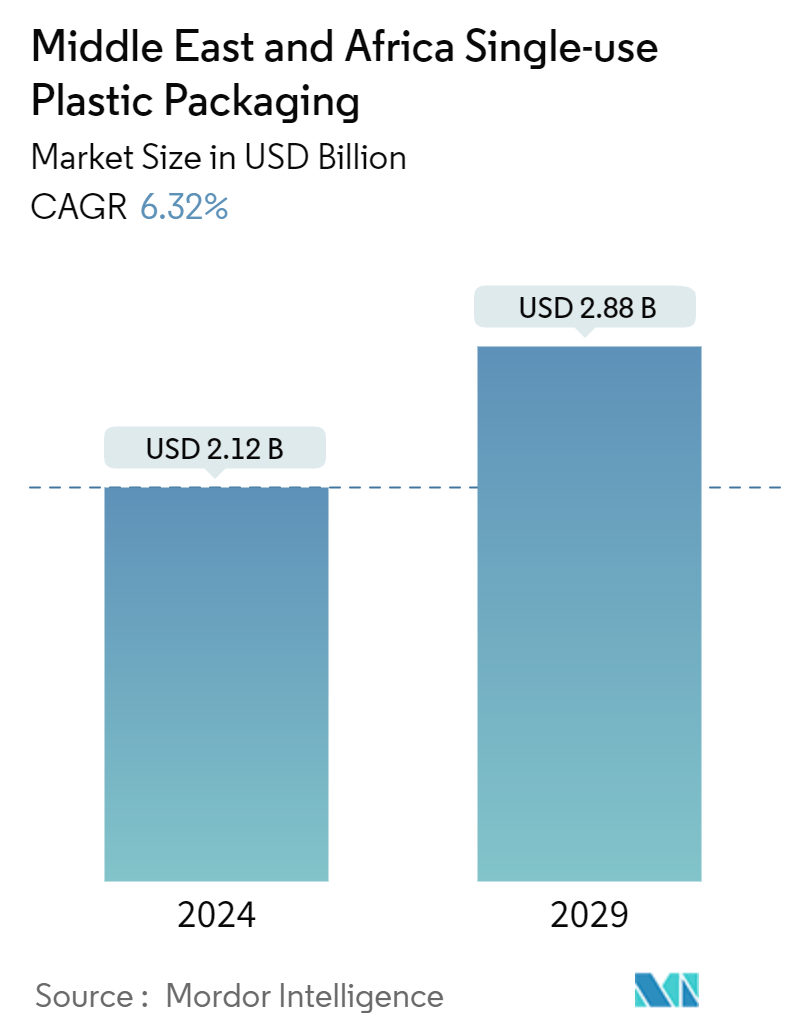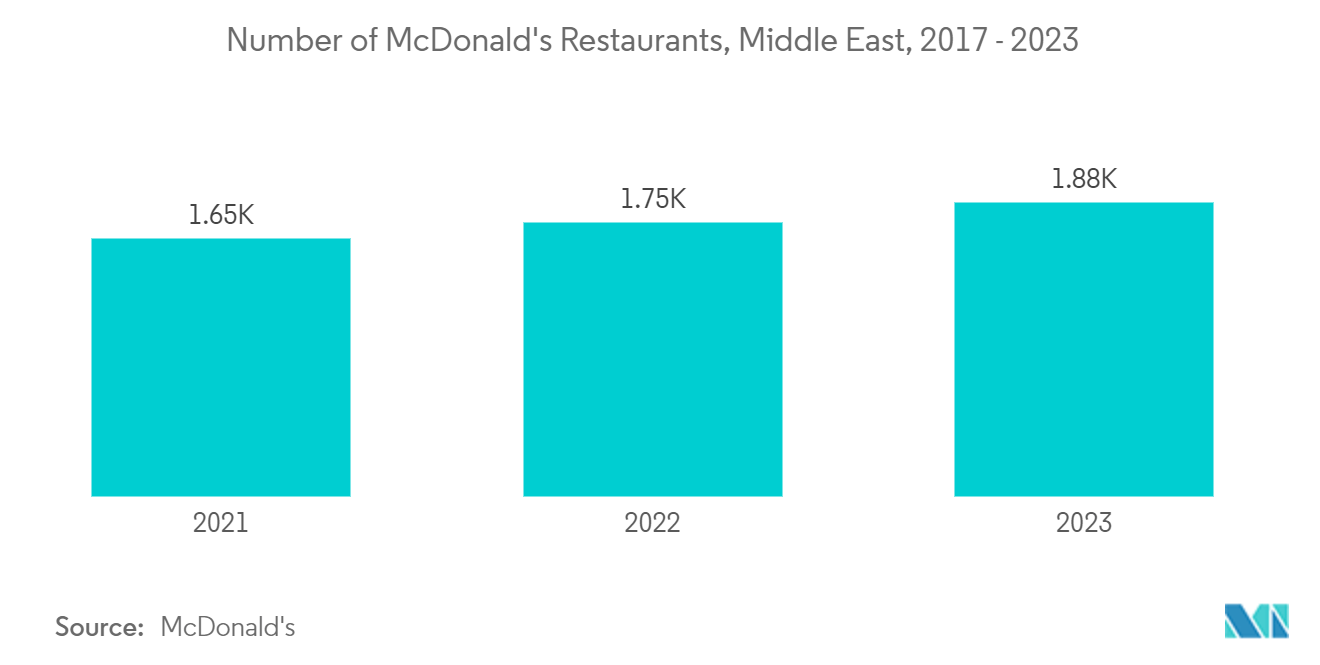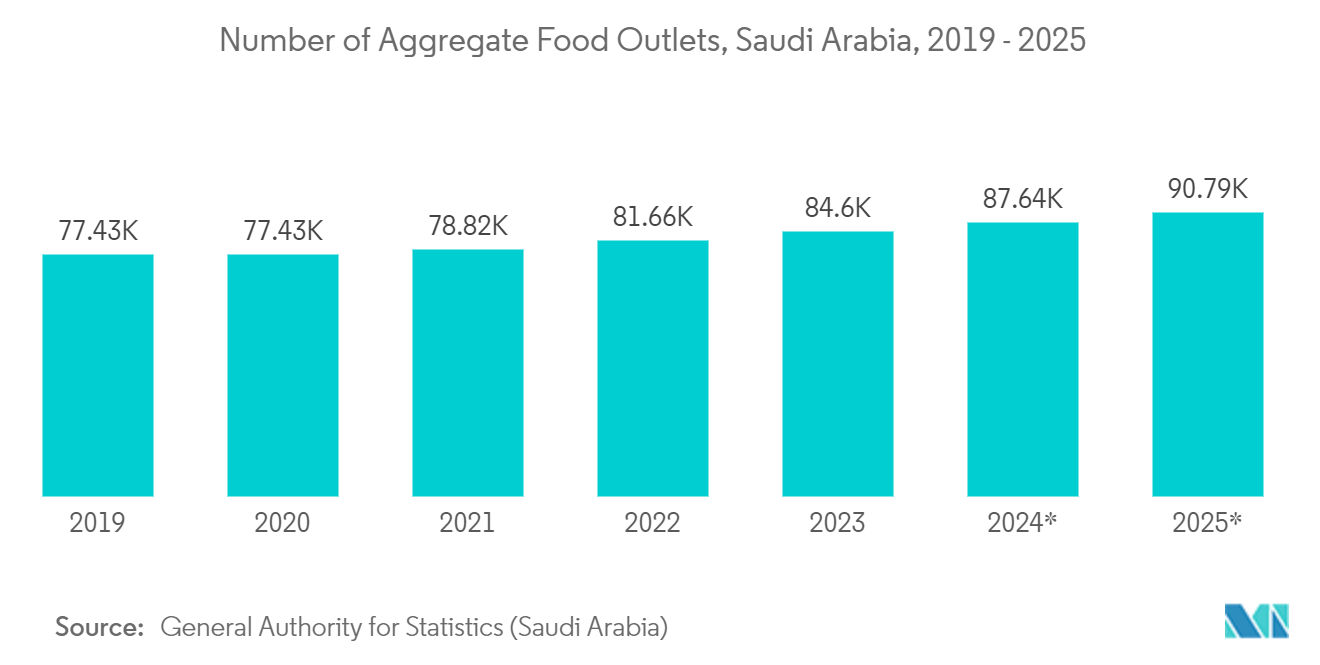Middle East And Africa Single-use Plastic Packaging Market Size

| Study Period | 2019 - 2029 |
| Base Year For Estimation | 2023 |
| Market Size (2024) | USD 2.12 Billion |
| Market Size (2029) | USD 2.88 Billion |
| CAGR (2024 - 2029) | 6.32 % |
| Market Concentration | Medium |
Major Players.webp)
*Disclaimer: Major Players sorted in no particular order |
Middle East And Africa Single-use Plastic Packaging Market Analysis
The Middle East And Africa Single-use Plastic Packaging Market size is estimated at USD 2.12 billion in 2024, and is expected to reach USD 2.88 billion by 2029, growing at a CAGR of 6.32% during the forecast period (2024-2029).
- Rapid economic growth, urbanization, and shifting lifestyles in the Middle East and Africa have fueled a rising appetite for ready-to-eat and takeaway food. This surge in demand has notably boosted the market for single-use plastic packaging, encompassing trays, plates, containers, and bowls. The region's substantial expatriate community, hectic work routines, and penchant for outdoor events further propels the demand for single-use plastic packaging. Additionally, the convenience and affordability of single-use plastic packaging make it a preferred choice among consumers and businesses, driving its widespread adoption across various sectors.
- Consumer convenience is a primary market driver, propelling changes in the foodservice packaging sector. As professionals juggle hectic schedules, they place a premium on convenience, notably in their dining choices. In response, manufacturers are crafting packaging solutions and focusing on easy disposal. This trend toward packaging that is effortlessly disposable not only caters to consumer demands but also resonates with the growing environmental consciousness. Companies increasingly turn to sustainable and biodegradable options, aiming to shrink their ecological footprint. Also, the sector is witnessing innovative packaging materials and designs that enhance functionality and user experience, such as resealable and microwave-safe packaging. These advancements are meeting consumers' immediate needs and setting new standards in the industry.
- The Middle East's foodservice and hospitality sector is rapidly expanding. The rise of internet-based meal delivery platforms has surged the demand for disposable food packaging, encompassing cups, plates, and containers. The necessity for online ordering and doorstep deliveries primarily fuels this heightened demand. As companies pivot towards online platforms for food distribution, the disposable packaging market is experiencing a notable upswing. Additionally, the growing trend of convenience food and the increasing number of foodservice establishments are further propelling the market's growth.
- Moreover, numerous global restaurant chains are expanding their presence in the Kingdom by launching new outlets. A case in point: Rebel Foods, in July 2023, inaugurated two cloud kitchens in Riyadh, Saudi Arabia. With ambitions to establish 60 internet restaurants in Riyadh and extend operations to cities like Jeddah, Dammam, and Khobar, Rebel Foods' aggressive expansion strategy is set to significantly boost the demand for disposable packaging, including boxes, cartons, bags, cups, and wraps in the future.
- Amid rising public concerns over packaging waste, particularly plastic, Middle Eastern governments are rolling out stringent regulations to curb environmental impact and enhance waste management. While commendable for sustainability, these measures are poised to exert a dampening effect on the market's growth trajectory. Given its adverse ecological and health ramifications, heightened environmental apprehensions surrounding plastic packaging will further hinder market expansion. Compounded by increasingly stringent regulations, the growth of the single-use packaging sector faces notable constraints. Governments are also investing in public awareness campaigns and promoting the adoption of alternative packaging materials to mitigate the environmental footprint.
Middle East And Africa Single-use Plastic Packaging Market Trends
Quick Service Restaurants to Hold Significant Market Share
- As technology reshapes the food industry and garners investments, the appetite for single-use plastic packaging is set to surge. The rise of online delivery platforms, mobile apps, and QSRs fuels this growth. In the Gulf region, many diners are turning to smartphone apps for meal orders, a trend poised to escalate alongside the surge in online food services. This shift broadens the reach of many small, standalone eateries. It amplifies the need for single-use plastic packaging, especially with the expanding presence of QSRs like food trucks venturing into online deliveries. Also, these technologies' convenience and efficiency drive consumer preference toward online food ordering, creating a robust market for single-use plastic packaging.
- Quick service restaurants (QSRs) prioritize fast service and affordability, often with minimal table service and a strong focus on self-service. Customers typically pay for their food and beverages before consumption. In recent years, the regional foodservice sector, particularly in these countries, has seen a surge in international QSR chains and local brands, catering to evolving consumer tastes with diverse cuisines. This growth is driven by urbanization, increasing disposable incomes, and a rising consumer preference for convenience. Additionally, technological advancements in food delivery services and digital ordering platforms have further fueled the expansion of the QSR sector.
- Single-use foodservice packaging has become a cornerstone of the region's fast-paced lifestyle, particularly in quick service restaurants (QSRs). As home meal preparation time dwindles, many turn to fast food. These single-use packages enable food establishments to efficiently and safely package meals, offering customers a convenient way to transport their food.
- Further, the franchise model is set to play a pivotal role in propelling the growth of QSR chains, thereby driving market expansion in the region. Regional authorities actively offer incentives to franchisees and franchisors, aiming to entice international brands and investors. These incentives are designed to facilitate their entry into the market, often in collaboration with seasoned local players. For instance, McDonald's, a prominent global fast-food chain, has steadily increased its store count annually. Starting at 1,650 stores in 2021, the company's footprint reached 1,880 by 2023.
- Several online food delivery companies are eyeing the Middle East to broaden their regional footprint. In April 2023, Deliveroo, a prominent food delivery app, expanded its operations to encompass the UAE, Kuwait, and Qatar. Having initially entered the Middle East through the UAE, Deliveroo aims to bolster its growth by amplifying its network of cloud kitchens.

Saudi Arabia is Expected to Witness Significant Growth
- The Saudi Arabian tourism sector is witnessing a notable shift as both public and private entities collaborate to broaden the Kingdom's tourist demographics and redefine the focus of tourism, moving beyond its traditional emphasis on business and religious travel. Projections from the World Travel and Tourism Council suggest that Saudi Arabia's travel and tourism industry is set to expand at an average annual rate of 11% over the next decade, positioning it as the Middle East's most rapidly growing market. This growth trajectory is poised to reshape the region's food and beverage landscape and align with Saudi Arabia's broader modernization and economic diversification strategies.
- The country’s changing social landscape indicates a solid long-term growth opportunity for the QSR industry. People are eating out more as many new entertainment options open. The nation’s leaders are aggressively pursuing strategies promoting greater inclusion of women in the workplace. Moreover, the trend of using more miniature packs to reduce packaging volumes is rising due to a simultaneous move toward single-serve packs in many end-user sectors, particularly the food and beverage sectors. This shift is driven by consumer demand for convenience and portion control, reshaping packaging strategies across the industry.
- The foodservice industry in Saudi Arabia prominently features a blend of local cuisine and well-known global brands. Notably, the fast-food domain, dominated by industry giants such as McDonald's, Subway, and KFC, epitomizes this fusion. As a result, there is a surging requirement for disposable packaging. This surge is primarily fueled by the convenience and practicality that disposable packaging provides, aligning with the swift pace of consumer lifestyles. Moreover, the rise of online food delivery services has heightened the urgency for dependable and eco-friendly packaging options.
- As the food and beverage industry expands, the growing number of food outlets in Saudi Arabia, rising from 77,431 in 2017 to 84,596 in 2023 and projected to hit 90,791 by 2025, highlights the pressing need for food service packaging that meets consumer preferences and regulatory standards. This outlet surge directly correlates with heightened consumption demands, driving the demand for various disposable food packaging solutions. The expansion of food outlets underscores the urgency for innovative and sustainable packaging solutions to cater to the evolving market dynamics.

Middle East And Africa Single-use Plastic Packaging Industry Overview
The Middle East and Africa single-use plastic packaging market is fragmented. Several global and regional players like Berry Global Inc., Amcor Group GmbH, Huhtamäki Oyj, and Hotpack Packaging Industries LLC are vying for attention in this contested market space. This market is characterized by low product differentiation, growing product penetration, and high competition.
- November 2023: PepsiCo. launched 100% recycled plastic bottles in the United Arab Emirates for its cola soft drink brands: Pepsi, Diet Pepsi, and Pepsi Zero Sugar.
- April 2023: Hotpack Global, a UAE-based manufacturer and supplier of disposable packaging, inked a significant deal with the Saudi Ministry of Industry. The agreement, valued at SAR 1 billion (USD 266 million), marks Hotpack Global's commitment to spearheading a specialized food packaging venture in Saudi Arabia. This project aims to enhance the food packaging industry in the region, leveraging advanced technologies and sustainable practices to meet growing market demands.
Middle East And Africa Single-use Plastic Packaging Market Leaders
-
Huhtamaki Oyj
-
Hotpack Packaging Industries LLC
-
Berry Global Inc
-
Amcor Group GmbH
-
Gulf East Paper and Plastic Industries LLC
*Disclaimer: Major Players sorted in no particular order
.webp)
Middle East And Africa Single-use Plastic Packaging Market News
- April 2024: SABIC, a global chemical industry leader, unveiled Saudi Arabia's inaugural circular packaging initiative under its TRUCIRCLE program to advance a circular plastic economy. FONTE, a prominent player in the Saudi Arabian bakery sector, has adopted SABIC's certified circular polyethylene (PE) for their Oat Arabic Bread packaging. These bags, crafted by Napco National, a Saudi manufacturer specializing in flexible film and packaging, utilize two food-contact certified circular polyethylene resin grades (LLDPE) sourced from SABIC.
- April 2024: Nova Water unveiled a water bottle crafted entirely from recycled bottles, aligning with the ambitious sustainability targets of Saudi Arabia's Vision 2030 and the Saudi Green Initiative. Notably, the bottle and casing are fashioned from 100% recycled materials. These eco-conscious bottles are a nod to environmental protection and a strategic move to bolster Saudi Arabia's circular economy and combat CO2 emissions.
Middle East And Africa Single-use Plastic Packaging Market Report - Table of Contents
1. INTRODUCTION
- 1.1 Study Assumptions and Market Definition
- 1.2 Scope of the Study
2. RESEARCH METHODOLOGY
3. EXECUTIVE SUMMARY
4. MARKET INSIGHTS
- 4.1 Market Overview
-
4.2 Industry Attractiveness - Porter's Five Forces Analysis
- 4.2.1 Bargaining Power of Suppliers
- 4.2.2 Bargaining Power of Buyers
- 4.2.3 Threat of New Entrants
- 4.2.4 Threat of Substitutes
- 4.2.5 Intensity of Competitive Rivalry
- 4.3 Industrial Value Chain Analysis
5. MARKET DYNAMICS
-
5.1 Market Drivers
- 5.1.1 Growing Demand In Online Food Delivery and Quick Restaurant Services
-
5.2 Market Restraints
- 5.2.1 Environmental And Health Risks
6. MARKET SEGMENTATION
-
6.1 By Material
- 6.1.1 Polyethylene Terephthalate (PET)
- 6.1.2 Polyethylene (PE)
- 6.1.3 Other Types of Materials
-
6.2 By Product Type
- 6.2.1 Bottles
- 6.2.2 Bags and Pouches
- 6.2.3 Clamshells
- 6.2.4 Trays, Cups, and Lids
- 6.2.5 Other Product Types
-
6.3 By End-user Types
- 6.3.1 Quick Service Restaurants
- 6.3.2 Full Service Restaurants
- 6.3.3 Institutional
- 6.3.4 Retail
- 6.3.5 Other End-user Types
-
6.4 By Country
- 6.4.1 United Arab Emirates
- 6.4.2 Saudi Arabia
- 6.4.3 South Africa
- 6.4.4 Egypt
7. COMPETITIVE LANDSCAPE
-
7.1 Company Profiles
- 7.1.1 Berry Global Inc
- 7.1.2 Amcor Group GmbH
- 7.1.3 Huhtamaki Oyj
- 7.1.4 Hotpack Packaging Industries LLC
- 7.1.5 Gulf East Paper and Plastic Industries LLC
- 7.1.6 Falcon Pack
- 7.1.7 Al Bayader International
- 7.1.8 Cristal Plastic Industrial LLC
- 7.1.9 Detpak - Detmold Group
- *List Not Exhaustive
8. INVESTMENT ANALYSIS
9. FUTURE OF THE MARKET
** Subject To AvailablityMiddle East And Africa Single-use Plastic Packaging Industry Segmentation
Single-use plastics, often also referred to as disposable plastics, are commonly used for plastic packaging and include items intended to be used once before they are thrown away or recycled. These include, among other things, grocery bags, food packaging, bottles, straws, containers, cups, and cutlery.
The Middle East and African single-use packaging market is segmented by material (polyethylene terephthalate [PET], polyethylene [PE], other materials), product type (bottles, bags and pouches, clamshells, trays, cups, and lids, and other product types), end-user type (quick service restaurants, full service restaurants, institutional, retail, and other end-user types), and country (United Arab Emirates, Saudi Arabia, South Africa, Egypt, and Rest of the Middle East and Africa). The market sizes and forecasts are provided in terms of value in (USD) for all the above segments.
| By Material | Polyethylene Terephthalate (PET) |
| Polyethylene (PE) | |
| Other Types of Materials | |
| By Product Type | Bottles |
| Bags and Pouches | |
| Clamshells | |
| Trays, Cups, and Lids | |
| Other Product Types | |
| By End-user Types | Quick Service Restaurants |
| Full Service Restaurants | |
| Institutional | |
| Retail | |
| Other End-user Types | |
| By Country | United Arab Emirates |
| Saudi Arabia | |
| South Africa | |
| Egypt |
Middle East And Africa Single-use Plastic Packaging Market Research FAQs
How big is the Middle East And Africa Single-use Plastic Packaging Market?
The Middle East And Africa Single-use Plastic Packaging Market size is expected to reach USD 2.12 billion in 2024 and grow at a CAGR of 6.32% to reach USD 2.88 billion by 2029.
What is the current Middle East And Africa Single-use Plastic Packaging Market size?
In 2024, the Middle East And Africa Single-use Plastic Packaging Market size is expected to reach USD 2.12 billion.
Who are the key players in Middle East And Africa Single-use Plastic Packaging Market?
Huhtamaki Oyj, Hotpack Packaging Industries LLC, Berry Global Inc, Amcor Group GmbH and Gulf East Paper and Plastic Industries LLC are the major companies operating in the Middle East And Africa Single-use Plastic Packaging Market.
What years does this Middle East And Africa Single-use Plastic Packaging Market cover, and what was the market size in 2023?
In 2023, the Middle East And Africa Single-use Plastic Packaging Market size was estimated at USD 1.99 billion. The report covers the Middle East And Africa Single-use Plastic Packaging Market historical market size for years: 2019, 2020, 2021, 2022 and 2023. The report also forecasts the Middle East And Africa Single-use Plastic Packaging Market size for years: 2024, 2025, 2026, 2027, 2028 and 2029.
Middle East And Africa Single-use Plastic Packaging Industry Report
Statistics for the 2024 Middle East And Africa Single-use Plastic Packaging market share, size and revenue growth rate, created by Mordor Intelligence™ Industry Reports. Middle East And Africa Single-use Plastic Packaging analysis includes a market forecast outlook for 2024 to 2029 and historical overview. Get a sample of this industry analysis as a free report PDF download.



